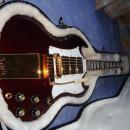Me interesó el tema. Seguí leyendo al respecto.
Encontré en un foro la respuesta de un Ingeniero de Micrófonos (eso dice "Mic Engineer") y explica lo siguiente:
Alguien escribió:
[...] Not if the mic has a balanced output, and is wired correctly. Even if the mic is a dynamic or ribbon type, phantom will not hurt the mic.
Phantom powering applies a positive voltage to pins 2 and 3 in the mic, and the ground of the phantom supply is connected to pin 1. In a condenser mic, pins 2 and 3 are wired to the circuitry inside the mic. Phantom current entering pins 2 and 3 goes through the mic circuit, then exits out pin 1 and returns to the supply ground.
In a dynamic mic or ribbon mic, pins 2 and 3 are wired to the mic’s voice coil or ribbon. Normally, the coil or ribbon is floating from the pin 1 ground. So the circuit loop to and from the phantom supply is incomplete. No current can flow through the mic’s voice coil or ribbon if you apply phantom power. Result: no damage.
On the other hand, if one end of the voice coil or ribbon is accidentally shorted to ground inside the mic, several milliamps of current from the phantom supply will flow through the voice coil or ribbon back to the ground of the supply. This current can deform the ribbon or immobilize the mic diaphragm.
In short, if the mic has a balanced output in which the voice coil or ribbon is NOT connected to mic ground, phantom will not damage the mic. If the mic has an unbalanced output because the voice coil or ribbon IS shorted to mic ground, phantom could damage the mic.
Hope this helps...
Bruce Bartlett
Mic engineer
[Edited by Bruce Bartlett on 08-11-2000 at 12:37]
Según lo que pude entender (y perdon si lo entendí mal), el phantom power es un voltaje positivo que entra por los pines 2 y 3. El pin 1 es conexión a tierra (o masa).
En un condensador los pines 2 y 3 van conectados al circuito interno del micrófono, entonces la corriente entra por allí y luego sale por el pin 1.
En un dinámico o uno de ribbon (micrófono de cinta o de velocidad) los pines 2 y 3 van conectados a la bobina pero esta no va conectada al pin 1, así que el circuito no se completa y no hay flujo de corriente, por ende no debería dañarlos. Pero si por algún motivo una terminal de la bobina se va a tierra por accidente o por mal cableado entonces le puede dañar la bobina o paralizar el diafragma del micrófono.
Si el micrófono tiene salida balanceada cuya bobina o cinta no esté conectada a la tierra del micrófofono, no hay daño.
La misma información la podemos encontrar en este otro artículo de Soundedevices.com:
http://www.sounddevices.com/tech/phantom.htm
En el último párrafo de phantom basics.
En el caso del ShureSM57 no habrá ningún problema y en todos los foros que leí nadie ha reportado un Shure de ese modelo dañado por Phantom Power.
En en algunos otros foros varios usuarios recomiendan apagar el phantom power antes de conectar o desconectar los micrófonos. No solo para evitar daños a micrófonos vintage (en los modernos parece que hay mejores compoenetes que resisten más), sino también para evitar ruidos estridentes o "pops" que puedan causar daño a los monitores.
http://socialsounddesign.com/questions/7976/is-it-bad-to-plug-in-a-mic-when-phantom-power-is-on
Bueno, eso ha sido todo

Saludos.













